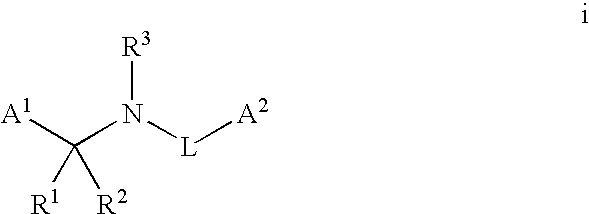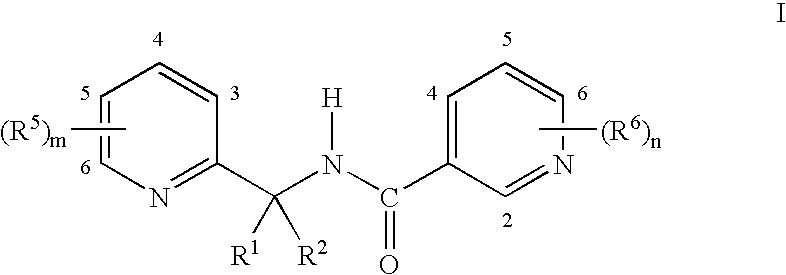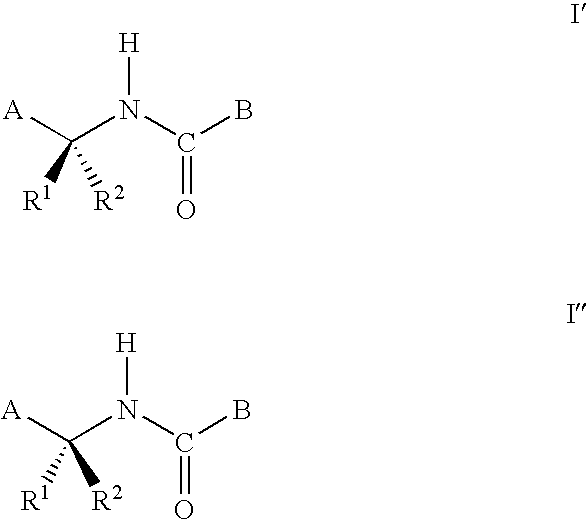Pyridinyl amides and compositions thereof for use as fungicides
a technology of pyridinyl amide and composition, which is applied in the field of pyridinyl amide, can solve the problems of increasing the cost of the consumer
- Summary
- Abstract
- Description
- Claims
- Application Information
AI Technical Summary
Benefits of technology
Problems solved by technology
Method used
Image
Examples
example 1
Preparation of N-[1-(5-bromo-3-chloro-2-pyridinyl)ethyl]-2,4-dichloro-3-pyridinecarboxamide
Step A: Preparation of 5-bromo-3-chloro-2(1H)-pyridone
A solution of 6.2 g of potassium chlorate in 100 mL of water was added to a solution of 25 g of 5-bromo-2-pyridone in 100 mL concentrated HCl pre-heated to 50° C. to 60° C. to form a thick precipitate that was stirred for 5 min. Then, 60 mL of water was added to facilitate stirring and the mixture was stirred at room temperature overnight. The reaction mixture was filtered, triturated with water (2×), and the precipitate was suction-dried to yield 17.7 g of the title compound as a solid.
1H NMR (CDCl3): δ 7.53 (d, 1H, J is 2.6 Hz), 7.75 (d, 1H, J is 2.5 Hz)
Step B: Preparation of 5-bromo-2.3-dichloropyridine
A mixture of 5-bromo-3-chloro-2(1H)-pyridone (i.e. the product of Step A) (17.7 g), PCl5 (10 g) in 100 mL POCl3 was refluxed for 4 hours with scrubbing. The reaction mixture was concentrated under reduced pressure to remove most o...
example 2
in analogous fashion to Example 1 using 2-bromo-3,5-dichloropyridine as the starting material and subjecting this material to conditions analogous to those described in Steps C (to prepare 3,5-dichloro-α-methyl-2-pyridinemethanamine) and D of Example 1 to give the title compound as a solid.
1H NMR (CDCl3): δ 1.58(d, 3H, J is 6.6 Hz), 5.7-5.8(m, 1H), 7.4(m, 2H), 7.77(m, 1H), 8.35(m, 1H), 8.40(m, 1H).
Examples of compounds of Formula I suitable for use in component (a) of the compositions of this invention include the following compounds of Tables 1-5. The following abbreviations are used in the Tables which follow: Et is ethyl, Ph is phenyl and CN is cyano. The substituents M, Q and R are equivalent to independent R5 substituents that have been located in the positions indicated. The substituents T, U and V are equivalent to independent R6 substituents that have been located in the positions indicated.
TABLE 1QRMT and V are both Cl and U is HClClHClBrHClOCF3HClOCHF2HClOCH2CF3HClOCF2...
example a
Active ingredients65.0%dodecylphenol polyethylene glycol ether2.0%sodium ligninsulfonate4.0%sodium silicoaluminate6.0%montmorillonite (calcined)23.0%
PUM
| Property | Measurement | Unit |
|---|---|---|
| composition | aaaaa | aaaaa |
| weight ratio | aaaaa | aaaaa |
| stereoisomers | aaaaa | aaaaa |
Abstract
Description
Claims
Application Information
 Login to View More
Login to View More - R&D
- Intellectual Property
- Life Sciences
- Materials
- Tech Scout
- Unparalleled Data Quality
- Higher Quality Content
- 60% Fewer Hallucinations
Browse by: Latest US Patents, China's latest patents, Technical Efficacy Thesaurus, Application Domain, Technology Topic, Popular Technical Reports.
© 2025 PatSnap. All rights reserved.Legal|Privacy policy|Modern Slavery Act Transparency Statement|Sitemap|About US| Contact US: help@patsnap.com



